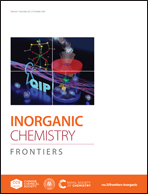A strategy for massively suppressing the shuttle effect in rechargeable Al–Te batteries†
Abstract
Aluminum metal is a promising negative electrode material for next generation rechargable batteries while the developed positive electrode materials of current aluminum batteries still have difficulty in meeting the demands for high energy density. With a higher electrical conductivity than that of sulfur and selenium in chalcogen-based positive electrode materials, tellurium with high theoretical specific capacity (1260 mA h g−1) still suffers from severe capacity loss induced by the chemical and electrochemical process in the Lewis acid electrolyte. For massively promoting the utilization of active materials and rechargeability at both positive and negative electrodes, a simple strategy is demonstrated to construct tellurium–aluminum batteries (ATBs) using acetylene black/polyvinylidene fluoride modified separators, and the assembled ATB delivers a discharge capacity of ∼1120 mA h g−1 (at 0.5 A g−1) and a considerably promoted capacity retention of 400 mA h g−1 after 300 cycles (at 1.0 A g−1). Such a simple approach offers a low-cost and high-efficiency strategy to develop advanced aluminium batteries with high capacity and energy density.



 Please wait while we load your content...
Please wait while we load your content...